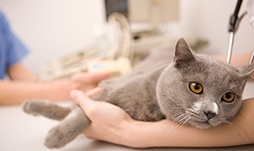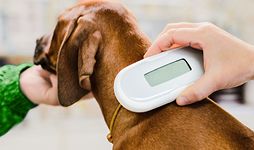Pet insurance
7 out of 10 customers renew their pet insurance with us*
Do you have a policy with us?
Make or track a claim, renew or get help with your pet insurance.
What is pet insurance?
Pet insurance can cover the cost of vet bills in the event your pet is injured in an accident or becomes ill. Restrictions apply, depending on the type of policy you take out. Having the right pet insurance can give you peace of mind if and when your pet needs to see a vet.
Compare our pet insurance cover levels
Basic (Time Limited)
Classic (Maximum Benefit)
Premier (Lifetime)
Vet fees limit
Vet fees limit
Vet fees limit
£1,500 or £3,000 for each accident or illness
Vet fees limit
£4,000 or £8,000 for each accident or illness
Vet fees limit
£1,000, £2,000, £4,000 or £6,000 for each accident or illness each year
Accident cover
Accident cover
Illness cover
Illness cover
Third party liability (for dogs)
Third party liability (for dogs)
Accidental damage
Accidental damage
Dental – Accident only
Dental – Accident only
Dental – Accident and Illness****
Dental – Accident and Illness****
Emergency boarding
Emergency boarding
Lost and found cover
Lost and found cover
Optional
Pets abroad cover
Pets abroad cover
Optional
Complementary treatment cover
Complementary treatment cover
Farewell cover
Farewell cover
Optional
Optional
****Dental care up to £2,000. Your pet must have a dental check every 12 months.
After your pet has had their first check and any necessary work has been completed, we pay for treatment for tooth decay or gum disease that occurs before the next 12 month check or at the time of the next check.
- For teeth or gums that have been damaged in an accident
- If an underlying illness causes tooth decay or gum disease
- To remove teeth to treat an illness that is not gum disease or tooth decay
Why choose our pet insurance?
We offer three levels of dog and cat cover to help you find the cover to suit your needs
24/7 vetfone service
Speak to qualified vet nurses any time, any day by freephone or video call with vetfone.
Claims made easy
We pay 9 out of 10 customer claims, so you don't have to worry about the unexpected. Based on MORE THAN claims data from December 2022 to November 2023.
Multi-pet discount
You can receive a 10% discount for each pet that you insure on the same policy. Discounts applied consecutively.
Pet insurance to suit your needs

Experts rate our Premier Pet Insurance
Our Premier Pet Insurance has achieved a 5 Star Defaqto Rating***.
How do we calculate pet insurance?
Different factors can affect the cost of your pet's insurance, such as:
- Age: As your pet gets older, their pet insurance costs increase. This is because older pets are more prone to illness.
- Breed: Differences between breeds can cause the cost of insurance to vary. This is especially the case if your pet is a pedigree.
- Advancing treatments: Improvements in veterinary care can increase costs of treatment.
- Claims: A claim being paid can also cause your renewal price to increase.
- Insurance Premium Tax: The government makes the decision to raise or lower this tax rate. This can cause pet insurance costs to go up or down.
There is a fixed excess on all pet insurance claims you make. At MORE THAN, you have the option to choose to pay a voluntary excess on each claim as well if your pet is under 9. This will mean you pay less every month or year.
What is the average cost of pet insurance?
On average, a MORE THAN customer pays £18.30** a month for pet insurance. This is the equivalent of £219.54 a year.
How much do vet fees cost?
We’ve put together the top 3 conditions found in dogs and cats and their average claims value. Based on MORE THAN data 1 January 2022 to 31 December 2023. Average cost paid out includes excess.
Common illnesses in dogs
- Lameness
Average claim of £1,005 - Special diet/stomach
Average claim of £107 - Poisoning
Average claim of £572
Common illnesses in cats
- Hyperthyroidism
Average claim of £1,173 - Special diet/stomach
Average claim of £143 - Euthanasia
Average claim of £161
More about our cover levels
Basic
Also known as Time Limited. Our Basic policy provides cover for each new accident or illness within a defined period. This will either be for 12 months from the first date of treatment or until your chosen vet fee limit is reached, whichever happens first.
Classic
Also known as Maximum Benefit. Our Classic policy provides cover for vet fees up to your chosen vet fee limit for each new accident or illness. There is no time limit in which you can use your vet fee limit.
Premier
Also known as Lifetime cover. Our Premier policy provides cover for vet fees up to your chosen vet fee limit for each new accident or illness each year. As long as you renew your policy with no break in cover, the vet fee limit is reinstated each year.
Ready to start a pet insurance quote?
What's not covered by insurance
- Vaccinations
- Spaying or castration
- Flea or worming treatments
- Grooming
- Microchipping
Useful guides
Important information
*MORE THAN data from January 2023 to October 2023
**Based on new customers who purchased annual cover. Excludes optional extras & includes any applicable discounts (MORE THAN data February 2022 - January 2023)
The cost of looking after your pet's health doubles every four to five years. That's why your renewal price increases each year and your excess will increase when your pet turns nine. If a claim is paid, the price you will pay next year can double.
It’s important you budget for renewal prices to increase as your pet gets older. There is no limit to how much your renewal price can increase over time.
***Our Defaqto Rating applies to Premier £1,000, £2,000, £4,000 and £6,000, and Classic £8,000



